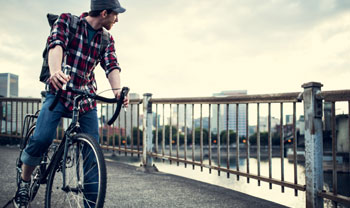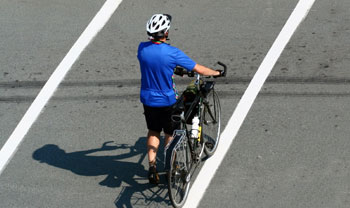The Rules of the Road for Safe Bicycling
 Bicycling is one of the great American family pastimes, one that is becoming increasingly popular. It’s no wonder: Biking is a low-cost way to get where you want to go, stay fit, have fun, and even help the environment by reducing your carbon footprint.
Bicycling is one of the great American family pastimes, one that is becoming increasingly popular. It’s no wonder: Biking is a low-cost way to get where you want to go, stay fit, have fun, and even help the environment by reducing your carbon footprint.
But bicycling is becoming increasingly deadly as well.
- While only 1% of trips are made by bicycle, bicycle accidents account for 2% of all traffic fatalities.
- In 2011, the last year for which data is available, the National Highway Traffic Safety Administration (NHTSA) reports that 677 bike riders were killed and another 48,000 were injured.
- Children under age 14 accounted for 59 of the deaths, and 8,000 of the injured.
- Florida was the deadliest state, ahead of more populous states like California, Texas, and New York. More than 5% of total bicycle deaths in the U.S. occurred in Florida in 2011.
There is no doubt that when an accident occurs, a bicycle is no match for a car or truck.
It seems logical that the risk of bike-car crashes could be lowered significantly by use of bicycle lanes. So many states, including Florida, have built hundreds of miles of bike lanes that permit cyclists to stay on the side of the road rather than compete with traffic.
As it turns out, bicycle lanes alone don’t make much of a difference. Dr. Dietrich V. Jehle, a professor of emergency medicine who headed a recent University of Buffalo study, says, “Our findings show that bike lanes or paved shoulders by themselves do not significantly reduce the severity of injuries sustained by cyclists when they crash with motor vehicles.” Dr. Jehle goes on to report that the major factors in bicycle-car crash deaths and injuries are:
- Alcohol – on the part of either the car driver or the cyclist;
- Lighting – after dark is more dangerous, even if there are street lights; and
- Speed – the higher the posted speed limit, the greater the risk.
So what can families do to protect both adults and children and make sure their biking adventures do not end in tragedy? Here are some answers. Some of them are the law, but others are just common sense.
The first rule of biking safety is to wear a helmet, regardless of whether or not your state requires it. Florida law says only cyclists under age 16 must wear helmets, but state agencies and safety advocates encourage adults to wear helmets too.
The NHTSA says that a properly fitting helmet is the single most effective way to prevent head injury from a bicycle crash. Here are some tips from NHTSA’s “Roll Model” bike safety program for buying the right helmet and making sure it fits:
- Measure your head (or your child’s head) before you shop and select several helmets in the right size to try on. Don’t buy a helmet to “grow into”; buy one that fits right now.
- In the U.S., bicycle helmets must meet standards set by the Consumer Product Safety Commission, so look for certification inside the helmets you are considering.
- Place your helmet level on your head and adjust the side pads or “fit ring” until the fit is snug but comfortable. The helmet should come down low enough on your forehead to be just one or two finger-widths above your eyebrows. Then adjust the side straps so that they form a “V” in front of and under your ears, and lock the slider.
- Most helmets are adjustable so you can pull the straps from the back to lengthen or shorten the chin straps. You should center the left buckle under your chin. If you have to make adjustments to do this, it will be easier if you take the helmet off to make them.
- Now buckle the chin strap and tighten it until it is snug. If more than one or two fingers fit under the strap, it is too loose and the helmet will rock forward and backward. If it rocks, the chin or back straps need shortening.
- Finally, roll the rubber band down to the buckle to anchor the straps. All four straps must go through the rubber band to prevent it from slipping.
Now that you know how to protect your head, use your head to learn and follow the rules of the road. Bicycle riders are considered vehicle operators, so they must obey traffic signs, signals and lane markings just like motor vehicle drivers.
In all states, when riding in the street, cyclists must ride in the same direction as traffic. Cyclists also must yield to traffic on a major or larger road, especially when coming out of a driveway or bike path, and yield to pedestrians in a crosswalk.
Here are some specific Florida regulations that you should know, summarized from Florida Statues Section 316.2065:
- A bicyclist has the same rights and duties as a driver of any other kind of vehicle on the roadway.
- Every bicycle must have a “permanent and regular” seat attached to it.
- Only one person at a time may ride a single bicycle. The only exception is for a child in a backpack or a seat/carrier designed for a child that protects him or her from the bike’s moving parts.
- Any rider or passenger under 16 years old must wear a properly fitted helmet that meets national safety standards.
- No one riding a bicycle may attach himself or herself to a vehicle on the road.
- Cyclists on a roadway may not ride more than two abreast, and then only if they do not impede traffic.
- Bike riders must keep at least one hand on the handlebars at all times.
- Between sunset and sunrise, bicycles in use must have a white light in front that is visible from at least 500 feet, and a reflector on the rear visible from at least 600 feet.
Additional guidelines for riding safety refer to constant alertness and your ability to anticipate potential hazards. You can’t always count on traffic patterns, road conditions, weather or other drivers and bikers; your life is in your hands!
- Stay alert: Watch for potholes, cracks, debris, railroad tracks, flooding, and parked cars – any conditions that could make you lose control of your bike. Listen for oncoming traffic and sirens. Listening means putting your iPod, cell phone and other electronic devices away so you can concentrate on riding safely.
- Ride in a straight line and use hand signals to indicate your direction. Teach your children how to signal to turn and to look behind to make sure there is no oncoming traffic. Don’t look down: Make eye contact with drivers around you to help you predict what they are going to do and to make sure they see you.
- Try not to hug the curb on narrow roads or bike lanes; use the whole street when it is safe. Riding close to the center of the road improves your visibility and keeps you from hitting a car door that may open suddenly.
- In order to be visible at night, illuminate yourself even beyond what the law requires by wearing fluorescent clothing and/or attaching reflective tape to your clothes and equipment. You can also increase your visibility by attaching strobe (flashing) lights on the front and back of your bike.
Parents can help their children find and follow safe biking routes, especially to and from school.
The best options for children who want to ride their bikes to and from school or to a neighbor’s house after school are streets where both speed limits and traffic volume are low and there are traffic signals, pedestrian crossing signals, and clearly marked crosswalks. Look for good lighting and the absence of overgrown bushes or other things that might block a bicyclist’s view. An especially welcome sign would be others out biking and walking, indicating that the route is safe and people are friendly.
Bike lanes or bike paths, if they are available in your area, are always the safest for children. If bike paths are not available, sometimes it may be safer for children to ride their bikes on the sidewalk, especially if they are under 10 years old or inexperienced.
You should check first to see if, where you live, bikes are allowed on sidewalks. Also make sure your child understands that sidewalk riding can be almost as dangerous as riding in the street. Pedestrians and motorists do not expect to see moving traffic, which poses crash risks at intersections and driveways.
- If sidewalk riding is permitted, children should be taught to ride slowly and to give pedestrians the right of way. Young riders should signal with a bell or call out when they are approaching and about to pass a pedestrian.
- Bike riders on the sidewalk must follow the same rules as pedestrians. For example, they should stop before crossing the street in order to make eye contact with motorists to make sure they are seen, and walk their bikes across the street inside the crosswalk just as pedestrians do.
- Sidewalk riders should be especially alert for cars coming out of driveways, and should enter and exit the street at a corner, not from between parked cars.
It goes without saying that other cyclists and motorists who practice safe driving are the best protection a biker can have. But you can’t always count on others to obey the laws or react quickly to unexpected events. That’s why, when you hop on your bike, safety is your responsibility.
Share This


